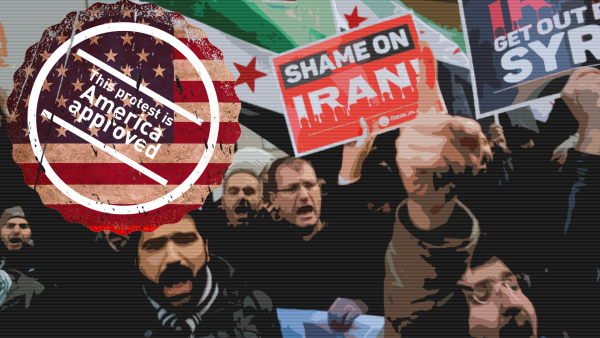- On Dec. 28, protests broke out in Iran
- Iranians are protesting against rising prices of basic goods and uneven economic growth
- Trump and other political leaders are manipulating the protests' messaging
- Trying to make Iran protesters look pro-Western, Trump may hurt their cause
By Ty Joplin
As protests in Iran continue into their sixth day, U.S. politicians, most notably Donald Trump, are misrepresenting the core demands and grievances of the Iranian people.
By portraying anti-government protests as an attempt by the Iranian people to show their pro-Western values and worldview, U.S. political leaders threaten to undermine an important moment in Iranian politics. Beyond obfuscating the actual demands of protesters to the outside world, the misrepresentation also risks sabotaging the ability of protesters to frame their own agenda independently of rash tweets broadly misdefining their movement for them.
After the successful negotiation of the Iranian nuclear deal, Iranian people felt optimistic that the global untethering of their economy thanks to the loosening of sanctions would give them a new wave of prosperity, or at least a boost.
Instead, many have seen their prospects worsened.
Youth unemployment is up to 27%, some factory workers have not been paid in months, and the price of everyday goods like bread and eggs are rising. The influx of money has thus far not trickled down past Iran’s elite, and this is what many news agencies are reporting is the source of the protests.
Iranians took to the streets on Dec. 28, chanting slogans like “Down with embezzlers!” “Death to the Revolutionary Guards,” and “People are paupers while the mullahs live like gods.”
U.S. political leaders, for their part, immediately sniffed an opportunity to bash Iran with the hopes to demonstrate to the world that even the Iranian people despise their own government as much as Congress and the White House does.
On Dec. 30, Trump’s tweets began.
- 21 Killed in Anti-Government Protests Across Iran
- US Calls for Emergency UN Session Amid Iran Protests
"Iran is failing at every level despite the terrible deal made with them by the Obama Administration. The great Iranian people have been repressed for many years. They are hungry for food & for freedom. Along with human rights, the wealth of Iran is being looted. TIME FOR CHANGE!" one tweet read.
Iran is failing at every level despite the terrible deal made with them by the Obama Administration. The great Iranian people have been repressed for many years. They are hungry for food & for freedom. Along with human rights, the wealth of Iran is being looted. TIME FOR CHANGE!
— Donald J. Trump (@realDonaldTrump) January 1, 2018
Trump also implied in a recent tweet that the U.S. would intervene to support the demonstrations, saying "Such respect for the people of Iran as they try to take back their corrupt government. You will see great support from the United States at the appropriate time!"
Such respect for the people of Iran as they try to take back their corrupt government. You will see great support from the United States at the appropriate time!
— Donald J. Trump (@realDonaldTrump) January 3, 2018
U.S. Congressman Will Hurd added his two cents: “The oppressive Iranian regime is of course trying to suppress the fact that protests against their tyrannical reign are popping up across Iran. The Ayatollahs are out of touch with their citizens and are exporting terror abroad. We should support a free and peaceful Iran. We should support the people of Iran who have had enough.”
Ted Cruz chimed in as well with a statement, “I call upon freedom-loving nations everywhere to rally behind and publicly express their support for the Iranian people.”
Even Israel’s Prime Minister Benjamin Netanyahu gave his support for the “brave Iranians” willing to stand up against the government which “wastes tens of billions of dollars spreading hate.”
The biggest problem with all these statements is this: they get Iran’s protests wrong on every level.
A protestor amidst tear gas in Iran (AFP)
Unlike the Green Revolution of 2009, which called for political reform and greater democratic transparency in governance, these protests are economic in nature, not political.
They do not call for greater civil liberties or political freedoms or even begin to show that the Iranian people view its government like how Trump views it: a rogue, terrorist state. To anybody who has noticed Iran’s ritual burning of American flags in its protests, this should be obvious.
As The Economist reports, it may have actually been the country’s religious hardliners who called for the protests. According to the U.K.-based publication, “preachers in Mashhad, Iran’s second city and a stronghold of the clerical regime, called their followers onto the streets on December 28th to protest against rising prices, most recently of eggs.”
Religious hardliners protesting against their government hardly fits the narrative that Iranians are taking to the streets to demand more secular freedoms. If anything, the kind of economic empowerment being demonstrated for could pose a geopolitical threat to the U.S.’ agenda in the Middle East if it helps to stabilize the economy of its biggest regional adversary.
Apart from simply being wrong and revealing a cynical political opportunism, the statements from political leaders are downright dangerous.
- Accept the Demands of Anti-Government Protesters: Iran's Deputy Speaker
- Meet the Iranian General who Orchestrated Iraqi Kurdistan’s Collapse
For the Iranian protesters, having such public support which characterizes their movement as one that is pro-Western could subject them to intensified government repression, who may see parts of the movement as a form of outside agitation. Beating back the protests then becomes a symbolic beating back of Western influence in their country. In other words, the governmental crackdown could get more violent.
The statements also misinform Western audiences about the demands of the protests, effectively shutting down the ability to provide popular solidarity with their economic grievances around the world. This isolates the protests, making it even harder for the demonstrators to develop pressure on the government--a task many analysts have concluded the protests are not doing well enough.
Most tragically, it seizes the narrative of economic deprivation away from the Iranian people, and refocuses the spotlight on political forces that Western countries would like to see fail, such as the Islamic Revolutionary Guard Corps (IRGC). And while the IRGC sucks up much of Iran’s money, drawing the ire of Iranians, it is not the exporting of terror or hate that leads to protesters calling for its downfall or restructuring.
The ongoing protests in Iran are important, and carry messages that much of the world can readily empathize with: that newfound economic gains are not reaching past the country’s elite.
But by manipulating the core of the protests for political gain, politicians threaten to neutralize the demonstrations and drown out what could be an effective avenue to air grievances against Iran’s dysfunctional economic structure.







